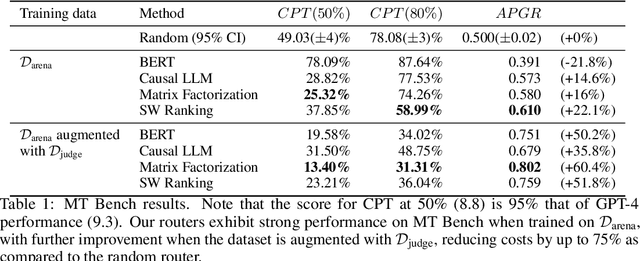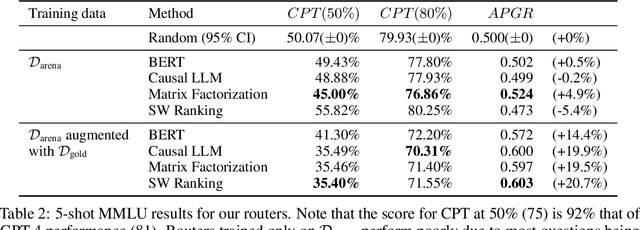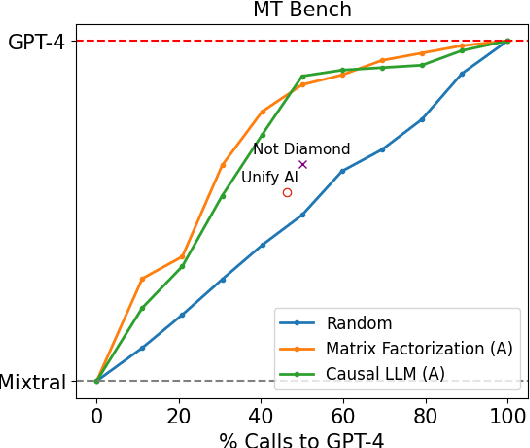Joseph E. Gonzalez
Managing Bandwidth: The Key to Cloud-Assisted Autonomous Driving
Oct 21, 2024Abstract:Prevailing wisdom asserts that one cannot rely on the cloud for critical real-time control systems like self-driving cars. We argue that we can, and must. Following the trends of increasing model sizes, improvements in hardware, and evolving mobile networks, we identify an opportunity to offload parts of time-sensitive and latency-critical compute to the cloud. Doing so requires carefully allocating bandwidth to meet strict latency SLOs, while maximizing benefit to the car.
How to Evaluate Reward Models for RLHF
Oct 18, 2024Abstract:We introduce a new benchmark for reward models that quantifies their ability to produce strong language models through RLHF (Reinforcement Learning from Human Feedback). The gold-standard approach is to run a full RLHF training pipeline and directly probe downstream LLM performance. However, this process is prohibitively expensive. To address this, we build a predictive model of downstream LLM performance by evaluating the reward model on proxy tasks. These proxy tasks consist of a large-scale human preference and a verifiable correctness preference dataset, in which we measure 12 metrics across 12 domains. To investigate which reward model metrics are most correlated to gold-standard RLHF outcomes, we launch an end-to-end RLHF experiment on a large-scale crowdsourced human preference platform to view real reward model downstream performance as ground truth. Ultimately, we compile our data and findings into Preference Proxy Evaluations (PPE), the first reward model benchmark explicitly linked to post-RLHF real-world human preference performance, which we open-source for public use and further development. Our code and evaluations can be found at https://github.com/lmarena/PPE .
HEnRY: A Multi-Agent System Framework for Multi-Domain Contexts
Oct 16, 2024Abstract:This project, named HEnRY, aims to introduce a Multi-Agent System (MAS) into Intesa Sanpaolo. The name HEnRY summarizes the project's core principles: the Hierarchical organization of agents in a layered structure for efficient resource management; Efficient optimization of resources and operations to enhance overall performance; Reactive ability of agents to quickly respond to environmental stimuli; and Yielding adaptability and flexibility of agents to handle unexpected situations. The discussion covers two distinct research paths: the first focuses on the system architecture, and the second on the collaboration between agents. This work is not limited to the specific structure of the Intesa Sanpaolo context; instead, it leverages existing research in MAS to introduce a new solution. Since Intesa Sanpaolo is organized according to a model that aligns with international corporate governance best practices, this approach could also be relevant to similar scenarios.
SuperCorrect: Supervising and Correcting Language Models with Error-Driven Insights
Oct 11, 2024



Abstract:Large language models (LLMs) like GPT-4, PaLM, and LLaMA have shown significant improvements in various reasoning tasks. However, smaller models such as Llama-3-8B and DeepSeekMath-Base still struggle with complex mathematical reasoning because they fail to effectively identify and correct reasoning errors. Recent reflection-based methods aim to address these issues by enabling self-reflection and self-correction, but they still face challenges in independently detecting errors in their reasoning steps. To overcome these limitations, we propose SuperCorrect, a novel two-stage framework that uses a large teacher model to supervise and correct both the reasoning and reflection processes of a smaller student model. In the first stage, we extract hierarchical high-level and detailed thought templates from the teacher model to guide the student model in eliciting more fine-grained reasoning thoughts. In the second stage, we introduce cross-model collaborative direct preference optimization (DPO) to enhance the self-correction abilities of the student model by following the teacher's correction traces during training. This cross-model DPO approach teaches the student model to effectively locate and resolve erroneous thoughts with error-driven insights from the teacher model, breaking the bottleneck of its thoughts and acquiring new skills and knowledge to tackle challenging problems. Extensive experiments consistently demonstrate our superiority over previous methods. Notably, our SuperCorrect-7B model significantly surpasses powerful DeepSeekMath-7B by 7.8%/5.3% and Qwen2.5-Math-7B by 15.1%/6.3% on MATH/GSM8K benchmarks, achieving new SOTA performance among all 7B models. Code: https://github.com/YangLing0818/SuperCorrect-llm
SimpleStrat: Diversifying Language Model Generation with Stratification
Oct 11, 2024



Abstract:Generating diverse responses from large language models (LLMs) is crucial for applications such as planning/search and synthetic data generation, where diversity provides distinct answers across generations. Prior approaches rely on increasing temperature to increase diversity. However, contrary to popular belief, we show not only does this approach produce lower quality individual generations as temperature increases, but it depends on model's next-token probabilities being similar to the true distribution of answers. We propose \method{}, an alternative approach that uses the language model itself to partition the space into strata. At inference, a random stratum is selected and a sample drawn from within the strata. To measure diversity, we introduce CoverageQA, a dataset of underspecified questions with multiple equally plausible answers, and assess diversity by measuring KL Divergence between the output distribution and uniform distribution over valid ground truth answers. As computing probability per response/solution for proprietary models is infeasible, we measure recall on ground truth solutions. Our evaluation show using SimpleStrat achieves higher recall by 0.05 compared to GPT-4o and 0.36 average reduction in KL Divergence compared to Llama 3.
Text2SQL is Not Enough: Unifying AI and Databases with TAG
Aug 27, 2024Abstract:AI systems that serve natural language questions over databases promise to unlock tremendous value. Such systems would allow users to leverage the powerful reasoning and knowledge capabilities of language models (LMs) alongside the scalable computational power of data management systems. These combined capabilities would empower users to ask arbitrary natural language questions over custom data sources. However, existing methods and benchmarks insufficiently explore this setting. Text2SQL methods focus solely on natural language questions that can be expressed in relational algebra, representing a small subset of the questions real users wish to ask. Likewise, Retrieval-Augmented Generation (RAG) considers the limited subset of queries that can be answered with point lookups to one or a few data records within the database. We propose Table-Augmented Generation (TAG), a unified and general-purpose paradigm for answering natural language questions over databases. The TAG model represents a wide range of interactions between the LM and database that have been previously unexplored and creates exciting research opportunities for leveraging the world knowledge and reasoning capabilities of LMs over data. We systematically develop benchmarks to study the TAG problem and find that standard methods answer no more than 20% of queries correctly, confirming the need for further research in this area. We release code for the benchmark at https://github.com/TAG-Research/TAG-Bench.
Post-Training Sparse Attention with Double Sparsity
Aug 11, 2024Abstract:The inference process for large language models is slow and memory-intensive, with one of the most critical bottlenecks being excessive Key-Value (KV) cache accesses. This paper introduces "Double Sparsity," a novel post-training sparse attention technique designed to alleviate this bottleneck by reducing KV cache access. Double Sparsity combines token sparsity, which focuses on utilizing only the important tokens for computing self-attention, with channel sparsity, an approach that uses important feature channels for identifying important tokens. Our key insight is that the pattern of channel sparsity is relatively static, allowing us to use offline calibration to make it efficient at runtime, thereby enabling accurate and efficient identification of important tokens. Moreover, this method can be combined with offloading to achieve significant memory usage reduction. Experimental results demonstrate that Double Sparsity can achieve \(\frac{1}{16}\) token and channel sparsity with minimal impact on accuracy across various tasks, including wiki-2 perplexity, key-value retrieval, and long context benchmarks with models including Llama-2-7B, Llama-2-70B, and Mixtral-8x7B. It brings up to a 14.1$\times$ acceleration in attention operations and a 1.9$\times$ improvement in end-to-end inference on GPUs. With offloading, it achieves a decoding speed acceleration of 16.3$\times$ compared to state-of-the-art solutions at a sequence length of 256K. Our code is publicly available at \url{https://github.com/andy-yang-1/DoubleSparse}.
Visual Haystacks: Answering Harder Questions About Sets of Images
Jul 18, 2024Abstract:Recent advancements in Large Multimodal Models (LMMs) have made significant progress in the field of single-image visual question answering. However, these models face substantial challenges when tasked with queries that span extensive collections of images, similar to real-world scenarios like searching through large photo albums, finding specific information across the internet, or monitoring environmental changes through satellite imagery. This paper explores the task of Multi-Image Visual Question Answering (MIQA): given a large set of images and a natural language query, the task is to generate a relevant and grounded response. We propose a new public benchmark, dubbed "Visual Haystacks (VHs)," specifically designed to evaluate LMMs' capabilities in visual retrieval and reasoning over sets of unrelated images, where we perform comprehensive evaluations demonstrating that even robust closed-source models struggle significantly. Towards addressing these shortcomings, we introduce MIRAGE (Multi-Image Retrieval Augmented Generation), a novel retrieval/QA framework tailored for LMMs that confronts the challenges of MIQA with marked efficiency and accuracy improvements over baseline methods. Our evaluation shows that MIRAGE surpasses closed-source GPT-4o models by up to 11% on the VHs benchmark and offers up to 3.4x improvements in efficiency over text-focused multi-stage approaches.
RouteLLM: Learning to Route LLMs with Preference Data
Jun 26, 2024



Abstract:Large language models (LLMs) exhibit impressive capabilities across a wide range of tasks, yet the choice of which model to use often involves a trade-off between performance and cost. More powerful models, though effective, come with higher expenses, while less capable models are more cost-effective. To address this dilemma, we propose several efficient router models that dynamically select between a stronger and a weaker LLM during inference, aiming to optimize the balance between cost and response quality. We develop a training framework for these routers leveraging human preference data and data augmentation techniques to enhance performance. Our evaluation on widely-recognized benchmarks shows that our approach significantly reduces costs-by over 2 times in certain cases-without compromising the quality of responses. Interestingly, our router models also demonstrate significant transfer learning capabilities, maintaining their performance even when the strong and weak models are changed at test time. This highlights the potential of these routers to provide a cost-effective yet high-performance solution for deploying LLMs.
From Crowdsourced Data to High-Quality Benchmarks: Arena-Hard and BenchBuilder Pipeline
Jun 17, 2024Abstract:The rapid evolution of language models has necessitated the development of more challenging benchmarks. Current static benchmarks often struggle to consistently distinguish between the capabilities of different models and fail to align with real-world user preferences. On the other hand, live crowd-sourced platforms like the Chatbot Arena collect a wide range of natural prompts and user feedback. However, these prompts vary in sophistication and the feedback cannot be applied offline to new models. In order to ensure that benchmarks keep up with the pace of LLM development, we address how one can evaluate benchmarks on their ability to confidently separate models and their alignment with human preference. Under these principles, we developed BenchBuilder, a living benchmark that filters high-quality prompts from live data sources to enable offline evaluation on fresh, challenging prompts. BenchBuilder identifies seven indicators of a high-quality prompt, such as the requirement for domain knowledge, and utilizes an LLM annotator to select a high-quality subset of prompts from various topic clusters. The LLM evaluation process employs an LLM judge to ensure a fully automated, high-quality, and constantly updating benchmark. We apply BenchBuilder on prompts from the Chatbot Arena to create Arena-Hard-Auto v0.1: 500 challenging user prompts from a wide range of tasks. Arena-Hard-Auto v0.1 offers 3x tighter confidence intervals than MT-Bench and achieves a state-of-the-art 89.1% agreement with human preference rankings, all at a cost of only $25 and without human labelers. The BenchBuilder pipeline enhances evaluation benchmarks and provides a valuable tool for developers, enabling them to extract high-quality benchmarks from extensive data with minimal effort.
 Add to Chrome
Add to Chrome Add to Firefox
Add to Firefox Add to Edge
Add to Edge